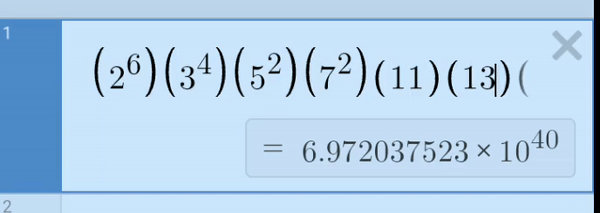Short Question, Long Number
How many digits does the least common multiple of the numbers 1 , 2 , 3 , 4 , ..., 1 0 0 have?
The answer is 41.
This section requires Javascript.
You are seeing this because something didn't load right. We suggest you, (a) try
refreshing the page, (b) enabling javascript if it is disabled on your browser and,
finally, (c)
loading the
non-javascript version of this page
. We're sorry about the hassle.
2 solutions
To find the LCM of the said sequence of numbers, we must find all largest p n , where p is a prime number and that p n < 1 0 0 , and multiply them.
The p n are:
2 6 3 4 5 2 7 2 1 1 1 3 1 7 1 9 2 3 2 9 3 1 3 7 4 1 4 3 4 7 5 3 5 9 6 1 6 7 7 1 7 3 7 9 8 3 8 9 9 7
The product of the numbers above is ≈ 6 . 9 7 2 × 1 0 4 0 , which has 4 1 digits.

Isn't there any other (more elegant) method to solve this?
Log in to reply
There is. Take log and then add the values. You'll get 40.52 something, accounting for 41 digits.
Log in to reply
I haven't studied log.
Log in to reply
@Vinayak Srivastava – Ok.... Then you need to multiply using a calculator.
There's no other way. This question is pure brute force only.
I was also on the path to multiplying all the primes, and its powers less than 100, but I thought there has to be a better way. If anyone get's another approach, please share!
As I said to Vinayak, you can take log and all all values.
here is a solution, that is fundamentally not different from what is provided by @Kaizen Cyrus . However, there are estimations involved, which may influence the accuracy of the final solution.
If we define L C M ( 1 , 2 , … , n ) = f ( n ) , then there is a relation
e Λ ( n ) = f ( n − 1 ) f ( n )
Λ ( n ) is Mangoldt function.
e Λ ( n ) ⋅ e Λ ( n − 1 ) ⋅ ⋯ ⋅ e Λ ( 2 ) = f ( n − 1 ) f ( n ) ⋅ f ( n − 2 ) f ( n − 1 ) ⋅ ⋯ ⋅ f ( 1 ) f ( 2 ) = f ( 1 ) f ( n ) = 1 f ( n )
For n = 1 0 0
e ∑ n = 2 1 0 0 Λ ( n ) = e ∑ n = 1 1 0 0 Λ ( n ) = f ( 1 0 0 )
It has been proven that
x → ∞ lim x ∑ n = 1 x Λ ( n ) = 1
hence ∑ n = 1 x Λ ( n ) can be approximated by x . Therefore, the answer to our question can be approximated to be
f ( 1 0 0 ) = e ∑ n = 2 1 0 0 Λ ( n ) ≈ e 1 0 0
the number of digits is calculated to be lo g 1 0 e 1 0 0 = 4 3 , which is 2 units away from the correct answer.